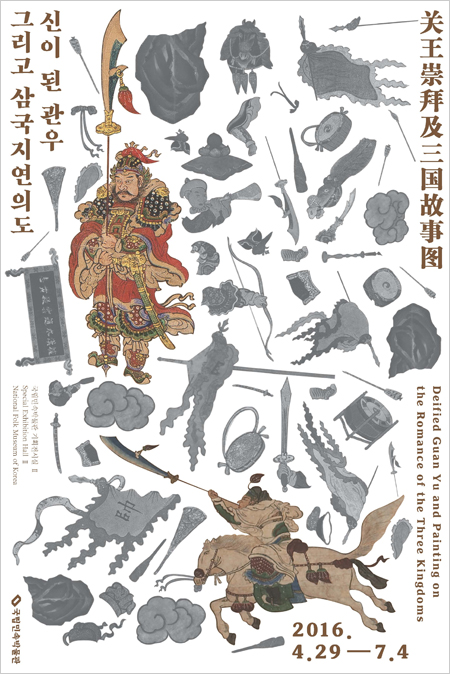
In this exhibition, information and documents closely linked to 《The Painting on the Romance of the Three Kingdoms》 and deified Guan Yu will be introduced. 《The Painting on the Romance of the Three Kingdoms》 is a large painting that decorates the Eastern Shrine(Dongmyo) where Guan Yu is worshipped as the deity. Guan Yu was a famous military generalin Shu Han, one of the three major states during the Three Kingdoms period; he also appears in the Records of Three Kingdoms.
《The Painting on the Romance of the Three Kingdoms》 located in Eastern Shrine is a painting work of art on the main characters and settings of the Romance of the Three Kingdoms, a novel written in the 14th century based on 『Records of the Three Kingdoms』. Folklorist Kim Tae-gon, courtesy name Nam-gang(1936-1996) collected the paintings and his wife, Madam Son Jang-yeon, donated them to National Folk Museum of Korea in 2012. For the past two years, National Folk Museum of Korea has preserved the paintings well in their original state. At the same time, folklorists, art historians and conservators proceeded with the research and studies of domestic and foreign documents on Eastern Shrine and deified Guan Yu. By analyzing the pigments of the paintings, they were able to find out that the artwork was painted in the late 19th century. Not only that, by comparing the measurements of the Eastern Shrine and the paintings, they were also able to figure out that 《the Painting on the Romance of the Three Kingdoms》 were hung on the walls of East and West Corridors of Eastern Shrine.
One will be able to grasp a general idea of how museums collect, preserve, study and exhibit historical artifacts through this exhibition. In addition, it will be an opportunity to witness the study results of researchers of various fields working together.
● Eastern Shrine (Dongmyo)
It is a shrine that worships Guan Yu as the deity. The temple consists of three outside doors, three inside doors, a main hall that is dedicated to the figure of Guan Yu, East Corridor and West Corridor. Southern Shrine was the first temple built to enshrine Guan Yu in Hanyang, the capital city of Joseon Dynasty; more shrines were built later in Andong, Seongju, Gangjin and other regions. Enshrined Guan Yu was first introduced in Korea in Joseon Dynasty, during Jungyujeran(1597-1598) by a general from Ming Dynasty, China. The worship ceremony for deify Guan Yu was promoted as a national level sacrificial worship during King Jeongjo’s ruling period. 《The Painting on the Romance of the Three Kingdoms》, a religious painting that represents Guan Yu as a religious figure at the time, is hung in the temple.
● Descriptive and Majestic Painting on the Romance of the Three Kingdoms.
《The Painting on the Romance of the Three Kingdoms》 is a drawing that shows the main setting and characters from 『The Romance of the Three Kingdoms』. It vividly shows the battle scenes of the heroes and important anecdotes of the time. These large scale paintings were hung on the East and West Corridors and were meant to dignify the solemnity of the shrine. The paintings were known to be hung in the main hall of the temple, however, the researchers of the National Folk Museum of Korea found out through studies that they were in fact hung on the walls of the East and West Corridors.
● Guan Yu as a Religion that has Infused into Our Lives
The worship ceremony fordeified Guan Yu was promoted as a national level sacrificial worship during Prince Gwanghaegun’s ruling period (1608-1623 Joseon Dynasty) and ever since King Sukjong’s ruling period (1674-1720), kings started to participate in the worship; King Yeongjo(1724-1776) was told to have participated 17 times in the worship ceremony. Deified Guan Yu as a religion prevailed during Emperor Gojong’s(1863-1907 the Korean Empire) ruling period, as such, shrines dedicated to worship deified Guan Yu were newly constructed in many regions including, but not limited to Hanyang, Jeonju, Ganghwa.
《The Painting on the Romance of the Three Kingdoms》, in which Guan Yu is an important character of, was already introduced prior to the 16th century. Thus the painting on the Romance of the Three Kingdoms was also popular. While the painting was used for religious purposes, parts of the painting were used as illustrations in books and also as decoration drawings on folding screens. Decorative artworks, in particular, were mentioned in an ancient novel titled 『Okdanchunjeon』 and a shaman song titled “Hwangjaepuri”. Many shamans worshipped Guan Yu specifically because he was known as a military general deity whom would give divine responses to shamans’ prayers. In fact, a kind of fortunetelling called “Gwanjaeyeomchung” was especially popular at the time for it held Guan Yu’s insight.
※ How The Painting on the Romance of the Three Kingdoms came to be in the Museum
《The Painting on the Romance of the Three Kingdoms》 of Eastern Shrine (Dongmyo) was donated by Madam Son Jang-yeon, wife of Folklorist Kim Tae-gon, to the National Folk Museum of Korea. We have well preserved the painting for two years, the exhibition came to place after having done research on the literary documents and conducted field studies. This exhibition was pushed forward with a form of museum-type research. In 2013, three professionals, a folklorist, an art historian and a conservator, co-applied to “Research and Restoration of the Original State of the Painting on the Romance of the Three Kingdoms” and were selected to proceed on the project. The final works are the composite result of their three different fields of studies.



